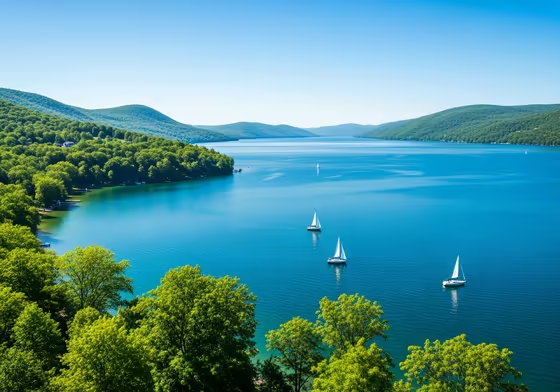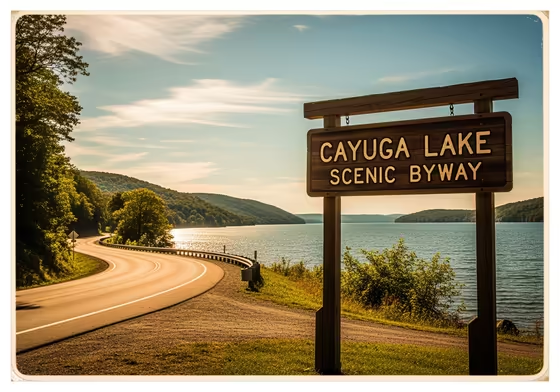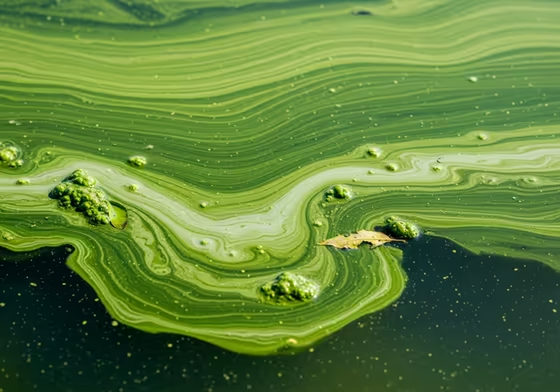A Guide to Cayuga Lake in the Finger Lakes
What is Cayuga Lake?
Cayuga Lake is the longest of New York's Finger Lakes. It's about 39 miles long and is a key part of the region. The lake connects the city of Ithaca at its south end to the Montezuma National Wildlife Refuge in the north.

The lake has a lot to offer. People enjoy boating and fishing in its deep, cold waters. Its shores have small towns like Aurora and Union Springs.
Cayuga Lake is also a place for learning and culture. It's home to Cornell University and Wells College. This brings a lot of art and good food to the area, especially in Ithaca, where the motto is "Ithaca is Gorges."
Cayuga Lake Facts and Figures
The size and shape of Cayuga Lake affect its environment and what you can do there. Here are some basic facts about the lake.
Table 1: Cayuga Lake: Key Facts & Figures
| Statistic | Measurement | Source(s) |
|---|---|---|
| Length | Just under 39 miles (63 km) | |
| Average Width | 1.7 miles (2.8 km) | |
| Maximum Width | 3.5 miles (5.6 km) | [1, 3, 8] |
| Shoreline Length | 95-106 miles | |
| Surface Area | 66 sq mi / 42,956 acres | |
| Maximum Depth | 435 feet (133 m) | [3, 8] |
| Average Depth | 179-181 feet (54.5 m) | |
| Water Volume | 2.5 trillion gallons / 2.3 cu mi | |
| Elevation | 381 feet | |
| Counties | Tompkins, Cayuga, Seneca |
The lake also has two small islands. Frontenac Island is near Union Springs and no one lives there. Canoga Island has summer camps on it.
Where is Cayuga Lake?
Cayuga Lake is in the middle of the Finger Lakes region in New York. It runs through Tompkins, Cayuga, and Seneca counties. Many towns border the lake, including Ithaca, Lansing, and Seneca Falls.
The city of Ithaca sits at the southern tip of the lake. It's the biggest town in the area and is known for its colleges and gorges. This is where most of the water from creeks flows into the lake.
The northern end is very different. It is a large, shallow marshland. This area is part of the Montezuma National Wildlife Refuge, which is an important spot for migrating birds.
About the Lake's Water
The lake was carved by glaciers, which is why it's so deep. This depth affects everything from its temperature to local industry.
Cayuga Lake is very deep, with a maximum depth of 435 feet. Its average depth is about 180 feet. This makes it the second deepest of the Finger Lakes.
The water in Cayuga Lake is very cold. Summer surface temperatures can feel nice, but the deep water stays around 39°F to 49°F all year.
Strong winds can cause the warm surface water and cold deep water to mix. This can make a swimming spot suddenly become dangerously cold. Cornell University actually uses this cold deep water to cool its campus buildings.
Cayuga Lake is a freshwater lake. But it has more salt than other Finger Lakes. This is because it sits on top of a huge underground salt deposit.
This salt deposit is why the Cargill Salt Mine is there. The mine operates 2,300 feet below the lake's surface. It has become a source of environmental concern.
- Mine History: The mine started in 1916 and is one of the deepest salt mines in North America. Cargill bought it in 1970.
- Mine Location: The mine extends under the lake, about a mile past Taughannock Point.
People worry about the mine collapsing. A similar mine collapsed in 1994. If this mine collapsed, it could permanently fill the freshwater lake with salt.
A collapse would ruin the drinking water for 100,000 people. It would also hurt the region's $3 billion tourism and farm economy. Because of this, the state is looking into the mine's safety.
Things to Do at Cayuga Lake
Cayuga Lake is a great place for outdoor fun all year. You can go swimming, fishing, and boating. The lake and its shores have something for everyone.

Swimming Spots and Parks
Yes, you can swim in Cayuga Lake at several public beaches. Be ready for a rocky lake bottom and potentially cold water. The best places to swim are in state and town parks with lifeguards.

- Taughannock Falls State Park: This is a very popular spot on the west shore. It has a large, sandy beach with a playground and picnic areas. The swimming area has lifeguards during the summer.
- Cayuga Lake State Park: Located at the north end of the lake, this park has grassy lawns that lead to the water. It has a medium-sized sand beach with lifeguards in the summer. There is a fee to enter with a car.
- Myers Park: This town park is in Lansing on the east shore. It has a swimming area with a lifeguard. It also has a marina and places to camp.
Table 2: Public Swimming Beaches on Cayuga Lake
| Park Name | Location (Shore / Town) | Lifeguard | Beach Type | Key Amenities | Entry Fee |
|---|---|---|---|---|---|
| Taughannock Falls State Park | West Shore / Ulysses | Seasonal | Sandy beach, rocky bottom | Playground, picnic tables, marina | Yes (Vehicle) |
| Cayuga Lake State Park | North End / Seneca Falls | Seasonal | Medium sand beach, sun lawns [31, 34] | Playground, cabins, boat launch [31, 37] | Yes (Vehicle) |
| Myers Park (Town of Lansing) | East Shore / Lansing | Seasonal | Small swimming area [38] | Marina, boat launch, camping | Yes (Per car, non-resident) |
Fishing on the Lake
Cayuga Lake has great fishing all year for many types of fish. Anglers come from all over to fish here. The lake is known for its coldwater and warmwater species.
- Fish Species: The deep, cold water is great for Lake Trout, Atlantic Salmon, Brown Trout, and Rainbow Trout. The shallow areas are good for Largemouth Bass, Smallmouth Bass, and Northern Pike. You can also find plenty of Yellow Perch and Bluegill.
-
Seasons and Locations:
- North End: The shallow, weedy northern part of the lake is famous for bass fishing and hosts professional tournaments.
- South End: Near creeks like Fall Creek, you can find salmon and trout in the spring and fall.
- Main Lake: The deep, open water is the best place to find Lake Trout, especially in the summer.
The lake is known for its huge bass. Two state records were recently caught here.
- NYS Record Largemouth Bass: In July 2024, an angler caught a 12-pound, 6-ounce largemouth bass, which set a new state record.
- NYS Record Smallmouth Bass: The lake also produced the state record smallmouth bass in 2022, weighing 9 pounds. That same fish was reportedly caught and released several times.
The bass are getting so big because of an invasive fish called the Round Goby. Gobies have become a huge food source for predator fish. This has helped them grow to record sizes.
Boating and Rentals
With almost 100 miles of shoreline, boating is a popular way to see the lake. There are many public boat launches and private marinas available.
- Public Boat Launches: New York State and local towns maintain several good boat launches around the lake.
Table 3: Public Boat Launches on Cayuga Lake
| Launch Name | County | Location (Near) | Ramp Type |
|---|---|---|---|
| Allan H. Treman State Marina | Tompkins | Ithaca | Concrete (8-lane) |
| Taughannock Falls State Park | Tompkins | Trumansburg | Concrete |
| Myers Point (Town of Lansing Park) | Tompkins | Lansing | Paved (3 ramps) |
| Long Point State Park | Cayuga | Aurora | Hard Surface |
| Mud Lock | Cayuga | Cayuga | Concrete |
| Frontenac Park | Cayuga | Union Springs | N/A |
| Cayuga Lake State Park | Seneca | Seneca Falls | Concrete |
| Dean's Cove State Marine Park | Seneca | Romulus | Concrete (2 ramps) |
Sources:
- Marinas and Rentals: If you don't have your own boat, marinas like Lansing Harbor and Hibiscus Harbor offer fuel and services. You can rent kayaks, paddleboards, and motorboats from places like Paddle-N-More and Cayuga Lake Boat Rentals.
- Tours: For a guided trip, companies like Discover Cayuga Lake Cruises and Ithaca Boat Tours offer scheduled tours on the water.
Towns Around the Lake
A great way to see the area is by driving the Cayuga Lake Scenic Byway. It's an 87-mile loop that goes around the whole lake. The route connects all the main towns and sights.
Ithaca: Gorges and Culture
Ithaca is the main city at the south end of the lake and a must-visit spot. The city is famous for its gorges and waterfalls.

- The Gorges: You can see amazing waterfalls at Taughannock Falls State Park, where the main waterfall is taller than Niagara Falls. Other popular spots are Robert H. Treman State Park and Buttermilk Falls State Park.
- Culture and Campus: A trail through Cascadilla Gorge leads from downtown Ithaca up to the Cornell University campus. You can also visit the Cornell Botanic Gardens, an art museum, and the Ithaca Commons, a downtown area with shops and restaurants.
Aurora: Historic Charm
On the east shore, you'll find the quiet, beautiful Village of Aurora. The town is home to Wells College and is known for its historic buildings. Many have been restored by the Inns of Aurora, a luxury resort.
Seneca Falls: A Piece of History
At the north end of the lake is Seneca Falls, known as the "Birthplace of Women's Rights."
- Women's Rights National Historic Park: This park includes several important sites. You can visit the Wesleyan Chapel, where the first Women's Rights Convention was held in 1848.
- National Women's Hall of Fame: This museum honors important American women throughout history.
Wineries and Craft Breweries
The Cayuga Lake Wine Trail was the first of its kind in the country. Dozens of wineries and breweries circle the lake. Many offer food, music, and great views of the lake.
How to Plan Your Visit
Getting to Cayuga Lake is easy. The area is close to major highways and has many different places to stay.
Getting to Cayuga Lake
You can easily reach the lake from major highways in the Northeast.

-
From Major Interstate Highways:
- I-90 (NYS Thruway): This is the main highway to the north end of the lake. Exits 40 and 41 will take you toward Seneca Falls.
- I-81: This highway runs north-south, east of the lake. Exit 11 for Route 13 will take you directly to Ithaca.
- I-86 (Route 17): This highway is south of the lake and connects to Route 13 North, which leads to Ithaca.
- The Scenic Byway Routes: Once you are there, the main roads around the lake are Route 89 on the west shore and Route 90 on the east shore.
-
From Major Cities:
- Syracuse: About a 1-hour drive.
- Rochester: About a 1.5-hour drive.
- New York City: About a 4-hour drive.
- Philadelphia: About a 4-hour drive.
Where to Stay
You can find everything from cabins to nice hotels around the lake. Your choice depends on the kind of trip you want.
- Lakeside Cottages and Rentals: This is the classic lake experience, perfect for families. You can find many options on rental websites, from small cottages to large lakefront homes.
- Ithaca Hotels: If you want to be close to Ithaca's restaurants and colleges, the city has many modern hotels. Options include the Marriott, Hilton, and The Statler Hotel at Cornell.
- Historic Inns: For a luxury trip, the Inns of Aurora offers rooms in beautifully restored historic homes. In Seneca Falls, The Gould Hotel is a modern hotel in a historic downtown building.
Water Quality and Safety
It's important to know about water safety before you go. The main things to watch for are cold water and Harmful Algal Blooms. Being prepared will help you have a safe and fun visit.
Is it Safe to Swim in Cayuga Lake?
Yes, the lake is usually clean and safe for swimming. But it's a large, natural lake, so you need to be careful. The water is generally good quality and is even a source of drinking water.
-
Open Water Safety Tips:
The lake's depth and cold water are serious risks.
- Know the Cold: Remember that the water can get very cold, very quickly.
- Never Swim Alone: Always swim with a buddy.
- Be Visible: Wear a brightly colored swim cap so boaters can see you.
- Enter Feet First: The lake bottom is often rocky and can have sharp zebra mussels.
- Know Your Limits: Swim parallel to the shore, not straight out into the lake.
- Avoid Blooms: Stay away from any water that looks cloudy or discolored.
About Harmful Algal Blooms (HABs)
The biggest water quality problem on the lake is Harmful Algal Blooms, or HABs. They usually appear in late summer when the weather is hot and the water is calm.

- What are they? HABs are made of a type of bacteria called cyanobacteria. These blooms can produce toxins that are dangerous for people and pets.
- How to spot them: You can't tell if a bloom is toxic just by looking. It's best to avoid all suspicious water. A bloom might look like spilled green paint, pea soup, or have streaks or green dots. The rule is: "When in doubt, stay out!"
-
Health risks for people and pets:
- Humans: Contact can cause skin rashes, eye irritation, nausea, and breathing problems.
- Pets (Especially Dogs): This is a life-threatening danger for dogs. The toxins can cause seizures, liver failure, and sudden death. There is no antidote, so it is critical to keep dogs out of the water if a bloom is present.
-
How to stay safe:
Don't just look at the water from the shore. Check official sources for the latest water quality reports before you go.
- CSI Cayuga Lake Map: The Community Science Institute runs a monitoring program with an interactive map. This is the best local resource for up-to-date information.
- NYSDEC NYHABS Map: The state's Department of Environmental Conservation (NYSDEC) has a statewide map of reported blooms.
-
NYS Parks Beach Status:
For state park beaches, check the NYS Parks website or call the park directly. They will close beaches if blooms or bacteria are found.
- Taughannock Falls State Park: (607) 387-6739
- Cayuga Lake State Park: (315) 568-5163
- Lansing Myers Park: (607) 533-7388 ext. 17
Table 4: HABs Safety: At-a-Glance Guide
| What to Look For | Health Risks (Humans & Pets) | What to Do (Avoid, Report) |
|---|---|---|
| "Spilled green paint""Pea soup" consistency"Parallel streaks" or "green dots"Surface "scum" or "paint-like" appearance | Humans: Skin rash, eye irritation, nausea, vomiting, stomach aches, breathing difficulties.[106, 107] | "WHEN IN DOUBT, STAY OUT!" |
| Pets (Dogs): FATAL, LIFE-THREATENING. Can cause seizures, liver failure, respiratory arrest, and sudden death. Seek vet care immediately. | Keep pets, children, and livestock away from the water.Rinse off immediately with fresh water if contact is made.Check the CSI and NYSDEC maps before you go. |
Sources: